| home > artland |
| Lanscape
with narratives. An English approach to Space Pietro Valle |
||||
| [in italiano] | An
asymmetrical, anti-geometrical space, one crossed by a multiplicity of
intersecting directions; a kinetic space that unfurls with the movement
through time, tied to the body, to the perception of those who cross
it; a space containing multiple durations, and that alternatively slows
down or accelerates its own representation; a space divided into many
places, each of which unfolds an individual narrative; a space that can
modify the appearance of the same shell, separating the meaning from
its materialization; a kaleidoscopic space, where the gaze breaks down
and bounces upon successive figures, that are linked only by an
additive memory; a space that invents an image of nature,
making it hyper-real,
intensified,
matter modified by representation and not divorced by it. These environmental descriptions seem to proceed in diverging directions: on the one side they speak of perception, physicality, place; on the other, they remove every relationship with fixed points: they expound movement, variation, the possibility of a temporary travesty. Do we find, in the experience of contemporary architecture, the notion of an environment that can build a relation between bodily perception and the illusion of representation? The open, transparent space of Modernism, the most widespread western canon, has long ceased to contain diversity: its aloof neutrality has made room for the power of those objects that have filled it and which now overflow with their own specificity. However, in the consumerist logic, objects are continuously replaced, thus between fixed form and continuous alternation there must be a network of relations giving a dimension and a duration to forms, albeit a temporary one. Is it possible to control such relations or, in the society of spectacle, are we doomed to enduring images and the ensuing erosion of physical space? Is it possible, in the recent history of architecture, to recognize the lines of enquiry that have faced the theme of impermanence without taking shelter in the longing for the past and without a blind celebration of progress such as the one acted by the avant-garde? In the last decades, modernity has been thoroughly investigated by a historiography free from the imperative of big narratives that characterized the manifestos of the Twentieth century. We have witnessed the emergence of various versions of the Modern, schools, lines that have broken up, unknown directions of inquiry crossing the events of architecture and technology. None of them, however, has confronted the problem of an unstable form to the same extent of the English tradition. Picturesque, Informal, Free-Style, Empirical: these are some of the terms that describe a certain approach to the typically British construction of space. A method that finds some of its most successful expressions in the Sixteenth century's Landscape Parks and in the Arts and Crafts single family house from the beginning of last century, two seemingly distant contexts that are actually linked by one and the same progressive outlook. The features of this space look very similar to the above-mentioned environmental descriptions: they can be synthesized in the rejection of a concluded architectural form and in the co-presence of diverse environments, each of which is left to coexist in a complex whole. The relations that develop between the parts of this microcosm are anti-hierarchical, they prefer to unfold in the kinetic-temporal crossing and are thus devoid of fixed points. If with landscape we mean a form of representation which can unify the perception of a territory, then the British approach to space treats any environment as a landscape and it accentuates the plurality by dividing it in recognisable episodes. The fragmentary universe of the English landscape, which can contain more narratives and is tied to individual experience, anticipates several themes connected to the multiplication of languages in the contemporary world, yet it is difficult to frame it in a recognisable formula. It secretly crosses the Twentieth century like a shadow, subtended to the whole evolution of modern architecture but scarcely recognised in its official histories, perhaps because it isn't connected to recognisable figures or to the development of technologies, perhaps because apparently indifferent to a social conscience. Yet this pragmatic anti-form, with its unrecognizableness, pervades the present much more than critical categories through which we are used to reading architecture: it has even overcome the premises of the Modern long before it was canonized. Why hasn't this tradition been acknowledged? And yet, why is it so influential? These are some of the questions that drive us to explore the diversity of British architecture and its parallel global impact through the diffusion of capitalism, which, incidentally, was invented in Britain with the industrial revolution, then exported all over the world. However, this inquiry cannot take place only through the study of documents and representations, in spite of the term picturesque being tied to images and even if there is a rich theoretical debate around it. It cannot grow systematically because the different contexts in which it manifests itself cannot be bundled up in classes and categories. It cannot abstract general rules, because of the deep pragmatism of British culture and its link with specific situations. What is left for us to do, therefore, is to go through some familiar places of this tradition and tell the dislocation of any centrality they cause, the experience of the movement that is present in them, which represents the idea of an endless change. Successive approximations to a definition of the characteristics of space in British tradition remain open, devoid of a referent. However they show that this environment isn't the infinite and modular space of modern architecture, it has no depth, it does not dematerialize: it is, on the contrary, the opposite of what we are used to recognising as a mark of progress. It looks closed, compartmentalized, archaic and, often, elitist. Yet it also speaks of modernity, of the fragmentation of experience, of parallel dimensions, of the lack of systems, but it does it without an ideal form, be it geometrical, technologic and, maybe, not even figurative, in that it welcomes and then abandons differing representations. The garden, reality of an invention with no use, and the domestic universe that articulates the everyday's activities are the two contexts in which British tradition unfolds the aforementioned qualities in a clearer way. Why did the British invent a natural garden and an informal house? The reasons are complex and multifarious, and it is not possible for them to be suitably analysed in this context. We can, however, attempt to isolate some historical moments which help to rebuild the making of an autochthon perception. To start with, there is Britain's insular condition, its isolation, which brings to a development which is autonomous from continental culture and the alternation of successive invasions carrying influences that are seen as external if relation to an internal. Britain ties and unties itself from Europe time and again, in that it is not actually connected with it, and it reads European forms in an autonomous an original way, bending them to its own purposes. There is also the deep tie with landscape, which is present since the first pre-historical settlements. In them one finds, for the first time, a mutual influence between the discovery of natural territory and the elaboration of artifices that make it perceptible, a theme that will become a classic of the Landscape Tradition. |
[December 18, 2009] | ||
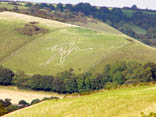 The Cerne Abbas giant, Dorset. 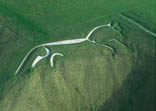 Vale of White Horse, Uffington. |
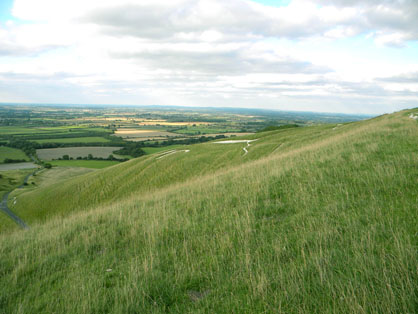 Vale of White Horse, Uffington. Landscape and the figure of the horse. In the South of the country there is a series of pre-historical sites where one finds big figurative representations inscribed in the ground, that treat the land like a gigantic tableau, a painting on a geographical scale. Sites such as the giant of Cerne Abbas in Dorset and the Vale of White Horse of Uffington in Wiltshire have been described as forerunners of Land Art, because in them nature and artifice mix up inseparably. This overlay of representation and landscape doesn't only show figures but also the place that embraces them. The giant or the horse, distinctly visible only from above, are set in panoramic sites from where one can gaze upon the surrounding territory for miles, along footpaths that used to connect distant cities. When looking for a vantage point to make out the figures, continuously distorted by the perspective flattening and changing according to orientation, the onlooker follows an itinerary opening up the surrounding landscape. The figure set in the ground doesn't then become the only focus of attention, but it works also as a pointer, inviting to the search for a position from which to observe the territory in an intricate game of focussing. The kinetic-temporal perception experienced when walking, not representable by a still image, can be found in other sites such as Maiden Castle near Dorchester, where one notices alterations of the ground created to build protective fences. Here, an entire hill is carved along its perimeter with four rings of green buttresses, gigantic earthworks on a territorial scale. |
|||
 Maiden Castle, Dorset. Aerial view. 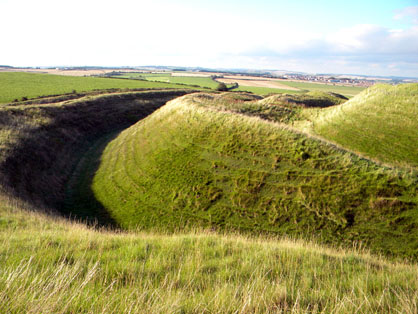 Maiden Castle, Dorset. The bastions. From the summit our gaze moves freely over the territory at three hundred and sixty degrees, but the route back up to the top must negotiate four depressions continuously bent and more than 15 metres deep. This delayed access provides an unrepeatable experience, akin to being inside a frozen whirlpool or at the foot of a endless dune. Yet the place is still a grassy hill, inhabited by flocks of sheep quietly grazing its sides. The artifice hides away, it camouflages itself. Where is the border between natural landscape and man's intervention? It is everywhere, pulverized at every moment on the way. (1) In architecture, the British Middle Ages and Renaissance (if we thus can call the Elizabethan and Jacobite period) develops the open relationship between representation and place that had already been introduced during pre-history in the dialogue between figure and space. The spontaneous culture of Empiricism culminates in the philosophical work of Hobbes and Locke, who systematize it: it is defined using terms such as anti-ideal, anti-absolutist, not linked to a priori principles but to specific situations, to the perception of the moment, to the response to functional needs. In architecture, it leads to the division of spaces according to single destinations without worrying to bring them together into a single system and to the avoidance of formal languages divorced from the places in which they are applied. The particular British inclination for ad hoc responses prefers the open form. Thus the occasional and additive architecture of castles, medieval palaces and the courtyards of the early colleges, proteiform organisms that change through time accepting alterations and extensions. |
||||
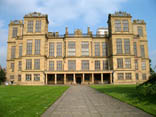 Robert Smyhtson, Hardwick Hall, Chesterfield, Derbyshire 1590. 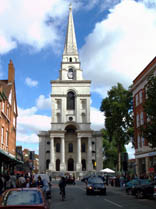 Nicholas Hawksmoor, Christ Church, Spitalfields, London 1714-29. |
This
is why Renaissance and Baroque forms, imported from France and Italy by
Elizabethan master-builders or by the early architects
Inigo Jones, Philip Webb and Christopher Wren, insert themselves onto
open distributive plants with "gothic" building solutions. This leads
to a dialectic between ideal
form and specific
function of buildings which are only seemingly Classic,
but that actually present secret discontinuities in their ante-litteram
functionalism. In the two hundred years going from the Sixteenth to the
Eighteenth century we witness the appearance of several indigenous
architectural forms cloaked with imported idioms that don't share
almost anything with Italian and French rationalism. An example are the
Elizabethan dwellings by the master-builder Robert Smythson
(1536-1614), extraordinary examples of a transparent architecture where
the Gothic building expertise meets the Classic language in the
production of homes pierced by tall reticular windows that seem to
anticipate the curtain-wall.
Another are the reform
churches
built by Nicholas Hawksmoor (1661-1736), after 1666's great fire of
London, idiosyncratic vertical montages of primary volumes that are
rich of exotic references (suffices to think of the reconstruction of
the Mausoleum of Halicarnassus on the spire of St. George in Bloomsbury
or the gothic spiral of Christ Church in Spitalfieds). (2) |
|||
| It
is with the reaction to the Industrial Revolution that this informal consciousness
get first formalized in a recognized theory and practice. This comes
about with the debate on the Picturesque and with the practice of the Improvements to
create the so called Landscape
Garden. In a moment in which the agricultural revolution
does away with free land with the phenomenon of the enclosures
and alters radically the shape of the landscape, culture invents a
primeval nature to be sheltered in protected areas. This compensatory
and nostalgic reaction teaches one to look at the landscape and to
search for a form
to counter
the serial organization of production. While the real territory gets
more and more artificial, the garden becomes more natural,
imitating the pre-industrial landscape. To the side of a parcelled and
rationalised countryside, those landowners who capitalize on
industrialized agriculture look for shelter into invented gardens,
recreated within their own lands and growing bigger and bigger, to the
point of becoming true regional parks. With a sort of paradoxical
inversion, the environmental situation rebuilt inside them becomes an
ambiguous signifier of the new capitalistic ownership. The same people
who operate a destruction of the landscape try to circumscribe the loss
within an ideal artifice, an imitation of the condition of nature. (3) |
||||
| If
previous gardens, of an Italian and French derivation, were based upon
single axial views of the owner's house and on a geometrical
organization of vegetation, the Eighteenth century English garden
builds a series of multiple and diagonal perspectives of pieces of
vegetation, informally arranged and composed in order to be experienced
when walking. This kinetic nature outlines a subsequent series of pictures where the
landscape's spontaneous
and irregular
elements come progressively into focus only to be immediately lost,
using techniques and accents deriving from the Seventeenth century
painting of artists such as Claude Le Lorrain, Gaspard Poussin and
Salvator Rosa. Along with the creation of the informal park we find the
development of a theoretical elaboration which builds, for the very
first time in history, an image of the landscape. In his Inquiry into the Origin of our
ideas of the Sublime and the Beautiful from 1757, Edmund
Burke had invented the categories of Beautiful and Sublime in order to
appraise natural phenomena; reverend William Gilpin, in his Three Essays: on Picturesque
Beauty, on Picturesque travel, on Sketching Landscape from
1792, adds the category of Picturesque. If nature is the archetype of the gaze for Gilpin, it must present its primeval condition with such characteristics as variety, irregularity and richness of accents, which should be able to stimulate the eye. It isn't then nature per se but an intensified and stageable reality which must always be reducible to an image. The "Picturesque" landscape, albeit conjuring up an untouched nature, is actually an artifice, a representation that uses spontaneous vegetation as a material, making reality and figuration overlap in a supreme anti-mimesis. It isn't then by chance that landscaped areas/reserves recreated within the farming estates take the name of Improvements: extensions, renovations, intensifications. The new gardeners (who henceforth would be called Improvers) actually operate by correcting the sites with alterations, additions and removals in order to extrapolate that picturesque image which is potentially present, but that only they are able to pre-view, as if they were artists painting with trees, hills and streams. |
||||
 William Kent. Design for Chatsworth's hill. |
This
recreated nature
contains time, not just the time it takes to cross the garden, but
history as a whole, in a quest for the origin that sets the various
stylistic periods in a primeval scenery from which the work of man
seems to emerge and towards which civilization sets, gradually turning
into a natural ruin.
The
landscape parks assemble multiple spaces and historical monuments in a
self-contained universe, a true reserve/collection in which objects are
more represented than actually present. Alongside the spatial
itinerary, classic temples, grottoes, huts, gothic spires, fake ruins
and the follies scattered around the park make for a backwards motion
in time, an experience superimposing aesthetics and naturalness. (4)
There is no doubt that, in composing their gardens, the early park
designers used the informal and additive experience already present in
the British Gothic, Renaissance and Baroque tradition. If the examples
and the sources are classical, the procedure is highly empirical and
employs the view and the sketch as design tools to produce a storyboard
of the garden's route. This is a significant reality for architectural
composition: movement and time are contemplated in the design process
and inscribed into the single sites. |
|||
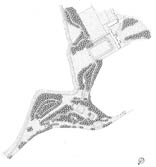 Rousham, Oxfordshire, 1720-37. Plan. |
 Rousham, Oxfordshire, 1720-37. Bowling Green. However, route and duration aren't here continuous but divided, multiplied, interlocked, oriented to enclose the variety in autonomous spaces, at times integrated but actually co-present, side by side. William Kent (1685-1748), architect and Charles Bridgeman (1690-1738), royal gardener, are the most important authors in the first generation of landscape parks. A visit to Stowe (1715-45) in Buckinghamshire (where we find later interventions that make a temporal comparison possible) but, above all, to the more contained Rousham (1720-37) in Oxforshire, unfolds all the complexity of this design art which doesn't want to be enclosed within a stable form. Assorted scales and depths are present at once, in a sort of synthesis of what within a few years would be parcelled out. Horace Walpole summed up Kent's invention distinguishing three contexts: the ornate farm (ferme orneé) which turns the farm building into an aesthetic object, the Forest, kingdom of the picturesque, and the garden which is connected to a park, which can open the house to the extension of nature. At Rousham, Kent adds two gothic wings to a Seventeent century country house, transforming it into a vast settlement that incorporates parts of the medieval monastery. The landscape park sits on the side of the owner's home and the latter keeps a portion of the formal garden in front of the entrance. Kent and Bridgeman use the expanse of a meadow, called bowling green, to offer the view of the distant countryside between two tree-lined wings. |
|||
 Rousham, Oxfordshire, 1720-37.  Rousham, Oxfordshire 1720-37. William Kent's Venus Vale. |
The
ownership of the estate is here reunited by a panoramic gaze,
originated in the intimacy of the house. This expanding is accompanied
by the green, as if this were a visual trampoline: it terminates in
fact with a steep slope which conceals to the view from the house the
informal part of the park and the brook the encircles the estate. Other
views on the external estate are negotiated by the ha-ha, an invisible
trench that allows the gaze to roam beyond the borders while at the
same time creating a physical barrier that keeps off animals and
strangers. We enter the natural wood by veering off to one side of the bowling green's
axis and brusquely going down a slope. The area covered by the park is
irregular and characterized by tight groups of trees forming some real
tunnels. All the routes are bending and not linear, interrupted only by
widenings in which one finds reconstructions of historical monuments:
the temple, the pyramid, the grotto, the Terrace of Preneste. These
structures are partially hidden in green clearings but set to form a
succession of triangulations which gradually open up, creating
different matches between the same subjects. A central terraced area
shows some monuments linked to water - a grotto, a waterfall, an
octagonal pond and the Venus Vale – declining towards the
river
to recall Villa Medici at Pratolino in Tuscany. |
 Rousham, Oxfordshire 1720-37. Terrace of Preneste by William Kent. |
||
 Stowe, Buckinghamshire, 1715-45. Temple of British Worthies in the Elysian Fields by Kent and Bridgeman. |
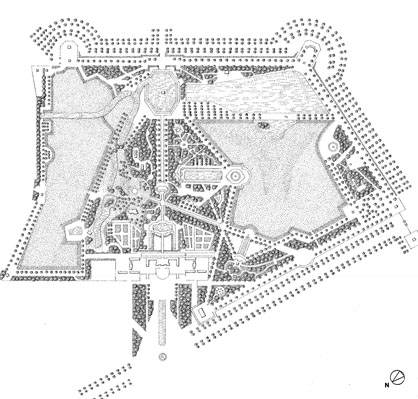 Stowe, Buckinghamshire 1715-45. Plan. The multiple network of relations between the widenings with the architectures creates continuous findings of the same point which make the park appear vaster than it actually is. After going through places, after rediscovering the same building in different routes and referring it to the lapse of distance, one realizes that Rousham's space is actually reduced, almost a miniature garden. The movement within the park thus is not the one in space-time, typical of a walk, but that of a mnemonic reconstruction of unity from a multiplicity of fragments. Rousham forces us to get lost in several different ways in order to find the place and appropriate it again and again without ever contemplate it in its wholeness. The eccentric vision of the distant countryside suddenly expands the gaze in fixed points of the paths, offering visual escapes which are centrifugal in relation to the inner network of the park. The borders between countryside and the organized representation of the park are eluded, and such endless alternation of loss and discovery remains unsurpassed even in relation to the larger Stowe, where Kent and Bridgeman are responsible for the sole central area of the Elysian Fields. Whereas at Rousham a unique place is reconstructed, at Stowe, which has undergone several enlargements, one has the impression of crossing different gardens, each with its own dimensions. But this is also a possible consequence of the Landscape Park: its extendibility which leaves untouched the single points, reinserting them into new relations at a distance. Each and every place is at once fixed and mobile, it has its own identity yet can be reinserted in a continuously changeable narrative. |
|||
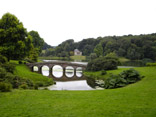 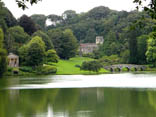 Stourhead, Wiltshire, 1740-60. |
Among
the early parks, Stourhead (1740-60), in Wiltshire, deservers a special
place. It was created by the banker Henry Hoare, who deviated the river
and created an artificial lake, spread over an entire valley. An
irregular ring path touches different stations set along the shore of a
pond, with a progression that has a deep allegorical meaning. The path
begins with birth in the Temple of Flora, it crosses the grotto of
Hades, it emerges from darkness to reach the Pantheon and, passing
through a rocky archway symbolizing mortality, it ascends towards the
Temple of Apollo on the top of a hill. Between gaze and circular path
there come some gaps that are filled only when one approaches a
specific architecture. This happens thanks to a skilful gradation of
the group of trees which, distanced one by one, create a continuous
visual alternation between seen and unseen. At Stourhead there aren't
any of the complex triangulations of Rousham and Stowe, but never as in
this place has one the feeling of a world which is detached from
reality and completely artificial. The closed valley, the circuit going
back to itself, the basin circumscribed between skilfully concealed
dams: it looks like an itinerary organized as to go through a
narrative, a real forerunner of the theme park. (5) |
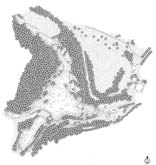 Stourhead, Wiltshire 1740-60. Plan. |
||
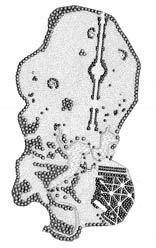 Blenheim Park, Oxfordshire, 1764. Plan. 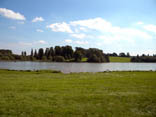 Capability Brown, Blenheim's Park, 1764. |
If
these three parks represent a co-presence of different approaches to
the landscape, the development of the art of Improvements
leads to the choice of one single way of managing informality.
Responsible for this synthesis is Lancelot "Capability" Brown
(1716-1783), who takes over at Stowe and invents a successful system
that, over few decades, will earn him the commission of hundreds of
parks, the biggest of which is the one at Blenheim Palace in
Oxfordshire (1764). Brown denies the multiplicity of spaces of the
early picturesque gardens and their mutual exclusivity. Key to his
approach is the concept of Appropriation,
the possibility to embrace the whole estate view with a single look,
which becomes a sign for wealth and success. Brown gives the measure of
the opening towards the horizon arranging groups of trees (clumps)
informally on a green that withdraws towards the infinite, reaching the
edge of the owner's house without the mediation of structured gardens.
The horizon, however, isn't free but inscribed in a tree belt, marking the
outer limit of the estate. An irregular pond creates an interval dividing a first, a second plane and the backdrop. Uniform opening, gradation of distance and closure of the horizon are Brown's three trademarks. If on the one hand he manages to expand the informal approach to the point of making it the exclusive language of British parks, on the other his method focuses on a seamless, almost Baroque space, one that is highly manipulative of the natural environment. Looking at Brown's portion at Stowe, the meandering Grecian Valley and the Expanse in front of the Palladian owner's house, one cannot help comparing them with Kent's and Bridgeman's parts. Here we find a contrived search for visual corridors that knock down any barrier, there there was the creation of isolated microcosms in which to get lost. In a sense, Brown's is a betrayal of the principles of variety that marked the theory of picturesque landscape in Gilpin's handbook and its realization in Kent's early parks. It isn't by coincidence that this generates a reaction which is central to the debate on the Picturesque and that sees two theoreticians (Uvedale Price and Richard Payne Knight) opposed to an improver (Humphrey Repton), who tries to defend Brown's practice and functional reasons. Both Price's Essay on the Picturesque and Knight's The Landscape, a Didactic Poem, both from 1794, defend the concept of Picturesque as nature's informal character against any alteration made by man. The landscape seems to be measured on its degree of resistance to artifice, even the one which tries to imitate its irregularities. |
 Capability Brown, Bowood, Wiltshire, 1762. |
||
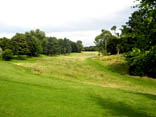 Stowe, Buckinghamshire, 1715-45. The Grecian Valley by Capability Brownan. |
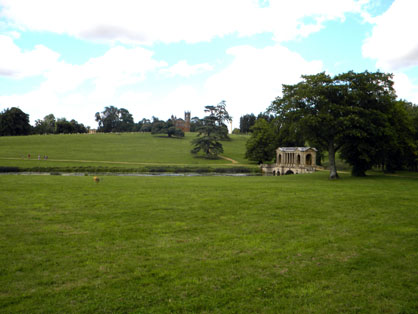 Stowe, Buckinghamshire, 1715-45. Palladian Bridge and Gothic Temple. However, if for Price the Picturesque is an objective trait, one that can be found in the pristine countryside untouched by the enclosures, for Knight, with a meaningful evolution, it is a perceptive element ascribable to the single person's character. Knight's An Analytical Enquiry into the Principles of Taste from 1805 marks the passage from the realist dimension of the picturesque landscape to an individualistic psychologism announcing the romantic season. The landscape doesn't seem to exist if not in the look of those who know how to observe it; perception, the construction of its image are acknowledged as a cultural artefact, not as an objective element. (6) If such development gives rise to distinct interpretations of the landscape in art and in romantic poetry, in the practice of Landscape Gardening it opens the way to an ever more composite manipulation of places by the Improvers, who have by now become professional gardeners. They now feel free to modify the sites according to their specific character, untied from univocal models, even from primeval nature. The beginning of the Nineteenth century marks in fact the historical moment in which the landscape park set within the agricultural estate, the dream of a secluded natural reserve, begins to disappear. |
|||
Meanwhile,
the problem of managing green spaces in the urban context arises, with
the birth of the public park and the garden in the middle class home,
cut out inside the new land subdivisions. The compositional methods
that have sanctioned the variety and informality of the Landscape Park
articulate themselves to reply to the increasing democratization of
landscape, but also to its reduction in scale. The key figure in this
evolution is Humphrey Repton (1752-1818), who embodies the transition
from a poetic dimension of the Picturesque to a pragmatic and
functional one. Capabilty Brown's strategies in creating widely
accessible parks, manageable in their maintenance thanks to the
subdivision of trees in discrete groups, are defended by Repton against
Price and Knight in his Sketches
and Hints on Landscape Gardening,
still from 1794. In a subsequent series of books, Repton clearly
expounds with an unprecedented clarity all the design strategies which
characterize the Picturesque, producing a sort of methodological
synthesis of previous experiences. He distinguishes the gardener's art
from the painter's, to which he had initially been associated, in at
least two crucial points. The first being that in a park the onlooker
is always moving, thus the designer hasn't the privilege to determine a
single vantage point. The other is that vegetation changes with seasons
and grows through time, therefore the gardener must calibrate a
modification the effects of which are not entirely controllable. Humphrey Repton, Tatton Park, Cheshire 1792, before and after. In order to absorb this temporal overlapping (personal, seasonal, epochal), Repton introduces an extraordinary method of representation of those modifications he brings to places. For a specific site, his Red Book presents a view of its current condition and, turning the two folds up of the page, the version modified by the project, with a sort of change of stage which lets one glimpse what is potentially inherent to the site itself. Repton is among the first to formalize the idea of modification starting from the specific characters of the site and the importance of the kinetic-temporal factor as a tool for gradating the landscape, two design themes which are not based upon absolute formal systems but rather on the search of the place as the only source of truth. Repton's attention for the here and now is not casual: he is called to operate in the chaos of the new urban centrality with the first public parks, and has to devise a system to dissimulate the narrow limits of the early bourgeois gardens. In these contexts, which are "unfree" and, above all, not quite controllable, Repton reintroduces the border for the garden, formalized portions of it and, what is more, a division in specialized subspaces which hide the promiscuity with other properties. |
||||
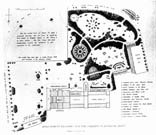 Humphrey Repton, Ashridge, Hertfordshire 1811. |
In
so doing, on the one hand he overcomes the principles of the
Picturesque as the garden's natural
language
and, on the other, he formalizes the co-presence of more spaces with
differing characters, reconfirming a tendency, typical of English
empiric perception, to respond to every function with a specific
environment. In a single park of limited size like Ashridge in
Hertfordshire, Repton proposes fifteen different types of garden, from
the geometric to the informal one, from an exotic theme to the one
imitating farmland. This tour
de force
transforms the estate in a sort of kaleidoscope of the real world,
which is now integrated in parts of the same garden, no longer in
single architectures set as an imitation to the pristine nature, as had
happened in the early Eighteenth Century parks. If in those instances
nature contained history, now it has become a chameleon that can
transform itself into more stories. The garden, like the cabinet of curiosities,
has become a collection, an encyclopaedia, a museum where, as Valery
said, the vertigo of
mixture rules. (7) John Claudius Loudon, Suburban villa within a garden, 1836. Repton's work belongs to an historical moment which sees the integration of the Picturesque principles into architecture itself and its marriage with stylistic eclecticism. John Nash (1752-1835) is the protagonist of such evolution and, not casually, he operates with Repton at the plan for the development of Regent's Park in London (1811-13) where, in a high-level speculative operation, he introduces some villas informally set in a new landscape park encircled with a ring of terraces overlooking the green. The same Regent Street that brings the principle of the park within the city, is planned as a sequence of urban views unfolding on a continuously curved path. The park's surprise factor is incorporated in different buildings transforming the new street in "an extemporization, a pictorial succession of architectural incident, moulded by luck and persuasion to the uncertain pattern presented by the disposal of sites in the speculative market.", as John Summerson defined it. (8) |
|||
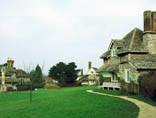 John Nash, Cottages in Blaise Hamlet, 1811. |
If
Nash offers always new views to the walk in central London, in the
countryside he transforms the bourgeois villa in a cottage: a
picturesque object on a small scale, artistically set on the backdrop
of a garden, that sees the integration of different styles. The Gothic
castle, the Italian country house, the vernacular British farm, the Moghul
temple meet in Nash's ingenious elaborations, which are not only
stylistic but also functional. Nash is aware of the new
representational needs of the urban bourgeoisie and is able to distil
the essence of its composite image within layouts the size of which is
economically accessible to more classes. His example marks the start of
a period that sees the publication of handbooks with different models
of homes to be imitated. The cottage thus becomes a sort of architectural game,
a kit of stylistic components to be assembled freely in endless
combinations and inserted in a landscape park concentrated
in a limited space. Adapting the complexity of the owner's house into
Nash's small suburban cottage and the ensuing reduction of the garden
with it subdivision into thematic areas introduced by Repton make up
one of the most ingenious contributions of British culture, one that
has inspired the creation of urban speculative estates organized around
a park, the birth of the garden city, the development of the whole
American suburban tradition and the local domestic revolution
during the Victorian and Edwardian period. |
|||
 Terraced house with staggered levels, London, 1880. Plan. |
Roger
Dixon and Stefan Muthesius, in their Victorian Architecture, remind us
that the Picturesque's fortune does not reside in the paradigm-like
nature of the early Eighteenth century parks, but in the dissemination
of their principles in architecture and urbanism throughout the
Nineteenth century to the point of influencing smaller scale design,
even that of a modest terraced house. Even inside a rigid framework,
the irregularity of walls and openings, the asymmetry of volumes and
jut-outs, create an architectural dynamics that animates the reduced
spaces. (9) During the
Victorian time,
gardens are articulated in thematic areas characterized by different
styles and periods at such a level to become, as in the case of
Biddulph Grange in Staffordshire (1840-61), some true theme parks which
seem to sum up all the exotic cultures that make up the emerging
British empire. The bourgeois garden follows the articulation of the
house in discreet areas, conceived as independent parts. The partition
is not only stylistic but it follows precise functional and
representational needs. In the garden, as in the house, the everyday is
broken up into multiple functions to each of which a specific space is
allotted. Bourgeois life framed by different thematic tableaux
(like in a positivistic taxonomy) but also by the crossing of
thresholds allowing their independence in a limited universe. Indeed,
the division helps to expand the borders of smaller and smaller
properties through the fragmentation of perception. The garden thus
becomes the paradigm of that household revolution which transforms the
British home during the Nineteenth century, reaching its peak in the
so-called free-style
of the Arts and Crafts
period at the beginning of the Twentieth century. The Picturesque in architecture is not simply a changing stylistic dress employed to articulate an external image, but an organization that starts from the single room to make up an open system of multiple relations. The promotional work for the garden carried out by John Claudius Loudon (1783-1843) through popular magazines and his 1836's The Suburban Gardener and Villa Companion is essential to relate the house's single spaces to the parts of the garden, establishing a mutual correspondence between the two environments. In the plan of a small villa set within a garden, Loudon suggests positioning the building at the edge of the plot so as to obtain a depth of view which is then split into more parts with different distances, linking them to each single room of the house. If from the drawing room the view embraces the whole garden, the dining room opens onto a lateral, limited external space and the breakfast room onto an octagonal flower garden divided into areas of different colours. Domesticity does not stop at the edge of the house but it creates (and, at the same time, is influenced by) its own external space. The radical specialization of each individual room to the point of creating a sort of symbolic representational correspondence between spaces and domestic actions, leaving open the relationships between rooms in such a way that the house on the whole remains a sort of unfinished aggregation, the discovery of the rooms as magic boxes opening up unexpectedly, with their own theme, the spatial dilation of the house's internal space through a careful gradation of paths and the creation of a delay in perceiving the relations between rooms: these are some aspects of the Nineteenth century English House, particularly of the country dwellings. If such articulation derives from functional needs and from the desire to represent the different groups inhabiting the house (owners, guests, servants), it has nothing of the art de la distribution marking the parallel development of the bourgeois building and apartment in continental Europe in general and in France in particular. 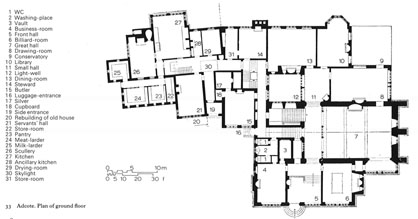 Richard Norman Shaw, Adcote, Shropshire, 1875. Whereas there we find the development of linear strategies such as the enfilade and the parallel corridor for the servants both leading to the same room, none of this takes place in England, where the division between served and serving spaces doesn't seem to exist and one goes from room to room through other thematic sub-spaces, in a complex hierarchy of thresholds and gradations. |
|||
| While
in France or in Germany rooms, like in the Renaissance rational
tradition, all have the same shape and are, if ever, characterized by
the interior decòr, in England rooms for different functions
have different sizes and heights, with various degrees of lighting and
opening to the outside. In them one can find subspaces like the
bow-window, the fireplace nook or the enclosure of the sitting area,
true rooms in the rooms that make space to differences in height and
multiple wall claddings inside the same room. It is as if the house
itself became an artificial
landscape to be discovered, crossed, a region with
different orographies, vegetations, densities. (10) Starting from the single room, the architects of the domestic revolution create unexpected planimetric aggregations which seem to be able to grow with subsequent additions. The house border becomes fleeting, while the hierarchies between the spaces remain firm. However, they aren't blocked by axes or prevalent directions joining two rooms. The movement inside the house, the layout, is continuously interrupted, it changes direction, it is asymmetrical, it follows circular rather than direct paths. All the solutions experimented in the landscape park come up again in the path inside the house, which seems almost to detach or to delay access to the rooms. The effect of a gradual discovery is functional to obtaining an effect of spatial dilation, assumed and rebuilt post-factum by a sum of local perceptions, just like at Rousham. |
 H.M. Baille Scott, Blackwell, Westmoreland, 1897-1900. |
|||
 Richard Norman Shaw, Leyes Wood, Sussex 1868, view. 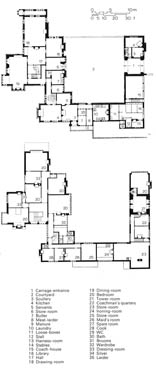 Richard Norman Shaw, Leyes Wood, Sussex, 1868. Plan. |
This
articulation in plan can include different sections for the various
rooms, but it is also inscribable into building shells of individual
forms and languages. The freedom of the English house is not ascribable
to a univocal style. It isn't true that the Arts and Crafts
period of Morris, Philip Webb, W.R. Lethaby, C.R. Ashbee, M.H.
Baille-Scott and C.F.A. Voysey, with its specific language, is the only
materialization of domestic freedom. The ingenious foretastes produced
by John Soane in his neoclassic interiors of early Nineteenth century,
by Richard Norman Shaw in Tudor
or Queen Anne
style from the Sixties, as well as Edward Luytens's eclectic epigones
in the first decades of the Twentieth century, prove how this freedom
is not stylistic but spatial and distributive. The same attitude links,
for example, two rebuilt medieval castles like Downton Castle in
Hertfordshire by the mentioned Richard Payne Knight, of 1774-78, and
Castle Drogo in Devon by Lutyens of 1912-25, which are divided by more
than a century and a half. The first has an envelope in Gothic style but it conceals a Neoclassic interior, with a reception room in the shape of the Pantheon, the second is a modernist villa dressed up as a Norman fortress. Both go in and out from their representational role, mindless of the spatial discontinuities that come to life or rather taking advantage of them to house rooms in the interstices between different structures. This design freedom is inserted onto a pragmatic and representational tradition that imagines living a space as a voyage moving us along different thematic stations through time. Each spatial episode wraps up like a protective shell almost as if it existed in itself, but the passage from one to the other recreates a virtual exterior where one can look for his or her position because it has not been given aprioristically. |
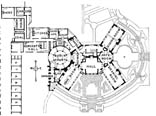 Edwin Lutyens, Papillon Hall, Market Harborough 1902-3. Plan. 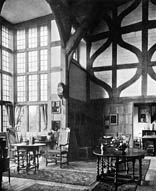 Edwin Lutyens, Deanery Garden, Sonning 1901-2. Hall. |
||
 Edwin Lutyens, Castle Drogo, Devon, 1912-25. If the informal garden affects the way one moves inside the house, the rooms' aggregate returns to the garden with a sequence of external platforms whose character is less and less entrusted to historical styles and more and more attained through a formal and coloristic use of vegetation itself. At he beginning of the Twentieth century, the couple Edwin Luytens architect (1869-1944) and Gertude Jekyll landscape designer (1843-1932), in a subsequent series of villas of different styles invents the Flower Garden tradition with a formal approach that organizes thematic enclosures featuring different colours and linked by lines of water, plainly of an oriental inspiration. Plants on the outside of Luytens's villas expand the interior spaces projecting each one of them onto a different enclosed garden. The negotiation of the different external spaces composes a sort of double of the house and each of them organizes a different look into the whole settlement house-garden, which is never seen as separated.  Lutyens e Jekyll, Deanery Garden, Sonning, 1901-2. Site plan. Instances of adaptation of pre-existing places such as Hestercombe in Somerset (1912) allow Luytens and Jekyll to place side by side a new sequence of green terraces, an Eighteenth century landscape park and a Victorian garden, composing a sort of synthesis of the Landscape Garden's history. The new levels are subdivided in flower enclosures which are rich in coloristic counterpoints and water reflections. All the containment walls, the flooring and the staircases are characterized by the use of rough stone which softens the geometrical edges in a pattern of extraordinary warmth. (11) |
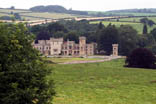 Richard Payne Knight, Downton Castle, Herefordshire, 1774-78.  Edwin Lutyens, Castle Drogo, Devon, 1912-25. Head and chapel. |
|||
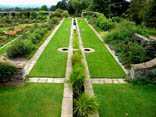 Lutyens e Jekyll, Hestercombe Gardens, Somerset, 1912. West Water Garden.  Lutyens e Jekyll, Hestercombe Gardens, Somerset, 1912. Plan. |
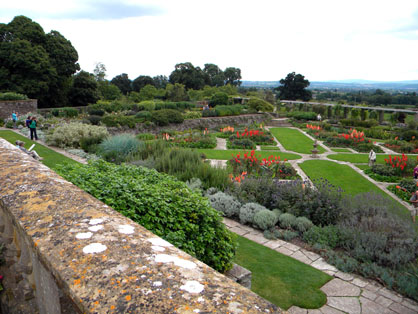 Lutyens e Jekyll, Hestercombe Gardens, Somerset, 1912. The Great Plat. The mixture of tradition and freedom of the English house is theorized for the first time in a book which is central to the development of modern architecture: Das Englische Haus, written in 1903 by Hermann Muthesius, architect attaché to the German embassy in London. It took a foreign, stranger's look to capture all the originality of the English house. Muthesius detects the source of division and of the corresponding articulation of the English house and garden in the invention of privacy. He writes: "…Thus the English room is a sort of cage, in which the inmate is entirely cut off from the next room. Englishmen usually shake their heads at the sight of a continental ground plan with its ubiquitous communicating doors and in a continental house they might feel as though they were perpetually sitting out in the street. They would see this as an interference with one of their most conspicuous needs, their desire for privacy, for seclusion…". The English house then creates domestic space, addressed to a single person, to his actions. The public parts are mediated, taken back to the micro-collectivity of the family, what is external is locked outside. The house, through its exasperated functionalism, becomes akin to a suit made to measure for its user. To Muthesius, such articulation appears to a sign for progress, a liberation from the imperative of absolute forms, of styles, of imposed social conventions. (12) |
|||
| In
his idealism, Muthesius abstracts some general norms for the English
house and imports them in continental Europe. He celebrates more
domestic functionalism and less the compositional informality or
stylistic freedom. Rather, Muthesius defends the Arts and Crafts
revolution: the obsession for the genuine handicraft is set against
historicism with an ideological misrepresentation which denies the
substantial linguistic eclecticism of English tradition. Das Englische Haus
will be one of the contributions influencing the debate of the German Werkbund,
whose interruption caused by World War One stops the spreading of
Muthesius's ideas. This marks the start of a curious divorce between
the evolution of central Europe's modern architecture, allegedly progressive, and
English domestic architecture which, even if it has influenced the
former, becomes relegated within the bed of the traditional
for having remained tied to historical languages. The substantial
stylistic indifference of English pragmatism, its adoption of a
specific language for each space, are at the antipodes of Modernism's
transparent space, of geometric abstraction, of the primacy of
technique, forms that are all read as invasive of that British privacy that can
cut out more spaces
within the same space. |
||||
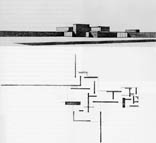 Mies van der Rohe, brick house, 1924.  W.E. Nesfield, Cloverly Hall, Shropshire, 1862. |
There
are deep analogies between some modernist projects and the freedom of
the English homes published by Muthesius: the plans of Mies Van Der
Rohe's first villas, for example, remind us of the additive homes
published in Das Englische Haus in the counterpoint of their successive
spaces projected towards the outside. The likeness however concerns
only the planimetric figure: Mies adopts a unitary abstract language
and anticipates a seamless and transparent space; inside the English
house, on the contrary, there are more languages and more enclosed
spaces that are irreducible with one another. Closer to the original
British spirit is Adolf Loos's reading in his Vienna's villas from the
beginning of the Twentieth century. With his Raumplan
(spatial plan), Loos translates into abstract forms the distributive
flexibility of the English house but doesn't submit the rooms to the
order of a single space. Instead, he creates a sequence of niches,
sub-spaces and split-levels in the transition between rooms,
emphasizing them with stone or wood claddings that transpose into a materic form the
eclectic figuration of English
Free Style. Loos's reference to a sort of interior landscape
with different levels bears remarkable influence on the development of
Modernism, yet it is never read as a form of space fragmentation,
but as an transitional stage towards Le Corbusier's plan libre, still
shrouded in traditional building forms. (13) |
 Adolf Loos, Villa Muller, Prague, 1930. |
||
| The
British picturesque tradition and domestic revolution have been quoted
as stages of formation of a modern spirit by Pevsner's and Giedion's
official historiography, yet they have been analyzed in their spatial
component only during the last decades. With the death of the great
narratives of technological progress, Postmodernism has rediscovered
the Picturesque but it has prevailingly connected it to stylistic
eclecticism. In his Complexity
and Contradiction in Architecture,
Robert Venturi quotes Soane, Lutyens and Arts and Crafts's free style
but, overlooking the relationship space-language, he reduces British
architecture to a stylistic game. (14)
A more effective interpretation is offered by Land Art in the
Sixties-Seventies, with the rediscovery of Eighteenth century Landscape
Park strategies and the acknowledgement of the fundamental contribution
it gave in promoting a kinetic-temporal reading of space. Notions of
moving perception, parallax, optical illusion, additive memory,
artificial orography and employment of the landscape as figurative
material abound both in the writings and in the practice of Robert
Smithson, Robert Morris, Richard Serra, Michael Heizer and Walter De
Maria. (15) |
||||
| Two
British artists, Richard Long and Hamish Fulton, get to the point of
using hiking as artistic material, documenting their walks through
natural territory and marking the land with archetypical signs
reminiscent of prehistoric sites such as Cerne Abbas, Uffington and
Maiden Castle. In Land Art, landscape
space
is prefigured as irreducible to the single picture and is, if ever,
articulated by subsequent displacements prompted by artworks on a
territorial scale, which involve the viewer's physical presence. In
them, like in the Eighteenth century park, a final boundary is never
given and the space opens up continuously towards an elsewhere
symbolizing art's open horizon. Artifice becomes the equipment for a
continuous projection of real places and this artistic experience
remains, perhaps, the most faithful evolution of Picturesque's
strategies in our time because based on relationships between space,
matter and representation and never on pre-established forms. In coeval architecture, two are the names getting more sense from re-reading the co-presence of parallel spaces in British informal tradition. They are connected to the United States' settlement culture and this shows how the British domestic revolution has deeply influenced American architecture, finding there a territory which was less conditioned by social hierarchies in which to express freely. Frank O. Gehry, in his first Californian homes, treats the domestic environment as an informal aggregate of simple building envelopes, almost like boxes, each of which has its own language. |
||||
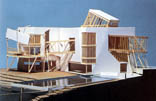 Frank Gehry, Familian House, Santa Monica, 1978. |
This
happens both in interiors (suffice it to think of Ron Davis house's
split levels, 1971) and on the whole (in the additive
settlements in the Seventies-Eighties homes). Rem Koolhaas, in the
theory of urban
congestion expounded in his Delirious New York,
acknowledges an inheritance of British informality in American
skyscrapers, showing how different thematic-spacial worlds can coexist
side by side in one and the same vertical container. (16) Both authors pursue a law of
contiguity of the unlike without a single spatial form as a connecting
element. In that, both Gehry and Koolhaas have sensed that the picturesque space is different from the organic or expressionist ones. However much informality is chased in their architecture, it needn't be clearly expressed: spatial freedom goes beyond its own image. There is no pursuit of figures looking like nature or trying to free themselves from geometry rule, through their irregularity. Instead, there is a quest for those conditions making more spatial forms co-present without being incorporated into a recognisable language. The compositional freedom of British free style could also be included in a set perimeter and expressed with a unitary architectural language: it is concealed inside these limits, yet leaving some open conditions to the co-presence of diverse environments, with a sort of process of space self-fragmentation. If in Germany's and Scandinavia's Organic-Expressionist school one sees a quest for a naturalistic symbolics, here there is a real anti-form, which is irreducible to a single representation. Perhaps this is also the reason why this tradition flows like a subterranean river. It is much more radical than the avant-gardes, forced to declare themselves through manifestos and communicable figures. On the contrary, here there is a design freedom which is indifferent to expression and capable of taking on more than one. This type of approach in architecture cannot be tracked back to the sole compositional analysis of the design plan, neither to the linguistic of styles nor to that of construction, since the latter takes different built forms. Only a survey of the functions' articulation, of the distribution of figures and of the spatial-temporal experience of a specific site can give an account of such spatial palimpsests. |
|||
 Tony Fretton, The Red House, Chelsea, London, 2001. |
Perhaps
this is the very reason why some of the most interesting proposals in
recent British architecture, set outside High-Tech
and the historicist pastiche promoted by Prince Charles, have been
overlooked in their provocative freedom. Already in the past decades,
James Stirling's architectural montages have passed nonchalantly
through a number of schools and –isms
that have tried to classify them. Even today, through the sophisticated
asymmetries one finds in the built works of Tony Fretton, Caruso
&
St.John, Maccreanor-Lavington and others, British architecture
continues to produce single cases of landscape displacement.
Seen in the light of the tradition we have attempted to single out,
these structures represent some oasis of complexity and resistance to
architecture's trivialization. From another point of view, in the
construction of western space this pragmatic and chameleonic approach
to architecture, through the influence of British culture, is perhaps
more widespread than one may think. It is the most articulated
expression of the split between signifier and signified in the world of
capitalistic alienation, of the ability to transform every spatial
reality in a communicable message and of the possibility of leaving
open the relationships between different individualities, so as to make
them always replaceable. Anti-form on the one hand is instrumental to
communicative unreality, on the other it has deep ties with physical
and temporal experience of places. Making them changeable has rendered
the infinite permutability of physical space possible. The origin of
the park in nature was a pretext, the aims much wider. Pietro Valle pietrovalle@hotmail.com |